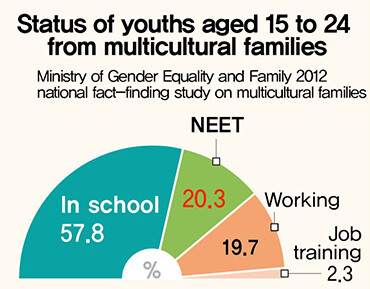hankyoreh
Links to other country sites 다른 나라 사이트 링크
More multicultural youths stuck out of education, employment or training

One out of every five youths (15 to 24 years old) in multicultural families in South Korea are neither going to school nor working, a recent study shows. Such people are referred to as “NEETs,” an acronym for “not in education, employment or training.”
While the number of children in multicultural families has increased around eight-fold over the past 10 years, this suggests that many of them have been unable to fully adjust to South Korean society.
The South Korean government has decided to shift the focus of its multicultural family policies from helping marriage immigrants become established to supporting children in such families. As part of these efforts, it will double the current number of multicultural kindergartens and increase the number of preschools designed to help them adjust to school life.
On Mar. 9, the government‘s Multicultural Family Policy Commission held its 12th session, chaired by Prime Minister Hwang Kyo-ahn. During the session, the commission deliberated these and other programs aimed at helping the children of multicultural families.
“Ten years have passed since we created the first programs to help multicultural families become integrated into society in Apr. 2006. In the future, we will focus on developing programs to help children at each stage of development,” the government said.
The number of children in multicultural families has greatly increased over the past 10 years. In 2006, there were around 25,000 such children (18 years or younger). By last year, the number had increased to 208,000.
Of these children, 82,536 were attending elementary, middle or high school last year, accounting for 1.35% of the total student population. The percentage of elementary school students who are from multicultural families surpassed 2% for the first time.
The percentage of multicultural students who drop out of school was 1.01% (as of 2014), which was higher than the overall dropout percentage of 0.83%.
An analysis of the data collected by the Ministry of Gender Equality and Family for a 2012 fact-finding study on multicultural families around the country suggests that students dropped out of school because of financial problems, relationships with friends and teachers and poor Korean language skills.
The Ministry also said that, because a large percentage of such families include stepparents, these children are also likely to experience high levels of stress at home.
Significantly, 20.3% of the children in multicultural families between the ages of 15 and 24 (as of 2012) were NEETs.
When this is narrowed down to children who were being raised overseas when they immigrated to South Korea because, for example, one of their parents remarried, the percentage of NEETs rises to 32.9%.
As of 2014, the overall percentage of South Korean young people (between 15 and 24) who are NEETs was around 14.5%.
The government is planning to expand customized support for each developmental stage, from kindergarten to the job search.
To provide assistance to infants and toddlers, the government will increase the number of multicultural kindergartens from 30, the figure last year, to 60 this year. Multicultural kindergartens, which were operated last year on a trial basis, teach Korean language to multicultural children, along with the usual subjects.
The government will also be running the “well-rounded program” for school-age children. Starting this year, psychological counseling and career counseling will be available at 81 multicultural family support centers around the country.
In addition, immigration offices are working on a plan to notify city and provincial offices of education when young people immigrate to South Korea. The objective is to help these children stay in school.
When such children have trouble documenting their academic record, the government will also help them with the process of transferring and being admitted to school.
By Hwangbo Yon and Jeon Jeong-yun, staff reporters
Please direct questions or comments to [english@hani.co.kr]

Editorial・opinion
![[Column] Park Geun-hye déjà vu in Yoon Suk-yeol [Column] Park Geun-hye déjà vu in Yoon Suk-yeol](https://flexible.img.hani.co.kr/flexible/normal/500/300/imgdb/original/2024/0424/651713945113788.jpg) [Column] Park Geun-hye déjà vu in Yoon Suk-yeol
[Column] Park Geun-hye déjà vu in Yoon Suk-yeol![[Editorial] New weight of N. Korea’s nuclear threats makes dialogue all the more urgent [Editorial] New weight of N. Korea’s nuclear threats makes dialogue all the more urgent](https://flexible.img.hani.co.kr/flexible/normal/500/300/imgdb/original/2024/0424/7317139454662664.jpg) [Editorial] New weight of N. Korea’s nuclear threats makes dialogue all the more urgent
[Editorial] New weight of N. Korea’s nuclear threats makes dialogue all the more urgent- [Guest essay] The real reason Korea’s new right wants to dub Rhee a founding father
- [Column] ‘Choson’: Is it time we start referring to N. Korea in its own terms?
- [Editorial] Japan’s rewriting of history with Korea has gone too far
- [Column] The president’s questionable capacity for dialogue
- [Column] Are chaebol firms just pizza pies for families to divvy up as they please?
- [Column] Has Korea, too, crossed the Rubicon on China?
- [Correspondent’s column] In Japan’s alliance with US, echoes of its past alliances with UK
- [Editorial] Does Yoon think the Korean public is wrong?
Most viewed articles
- 1[Column] Park Geun-hye déjà vu in Yoon Suk-yeol
- 2Thursday to mark start of resignations by senior doctors amid standoff with government
- 3[Editorial] New weight of N. Korea’s nuclear threats makes dialogue all the more urgent
- 4Will NewJeans end up collateral damage in internal feud at K-pop juggernaut Hybe?
- 5Why Korea shouldn’t welcome Japan’s newly beefed up defense cooperation with US
- 6[Guest essay] The real reason Korea’s new right wants to dub Rhee a founding father
- 7Kim Jong-un expressed ‘satisfaction’ with nuclear counterstrike drill directed at South
- 8[Column] ‘Choson’: Is it time we start referring to N. Korea in its own terms?
- 9N. Korean hackers breached 10 defense contractors in South for months, police say
- 10[Column] Yoon’s first 100 days should open our eyes to pitfalls of presidential system